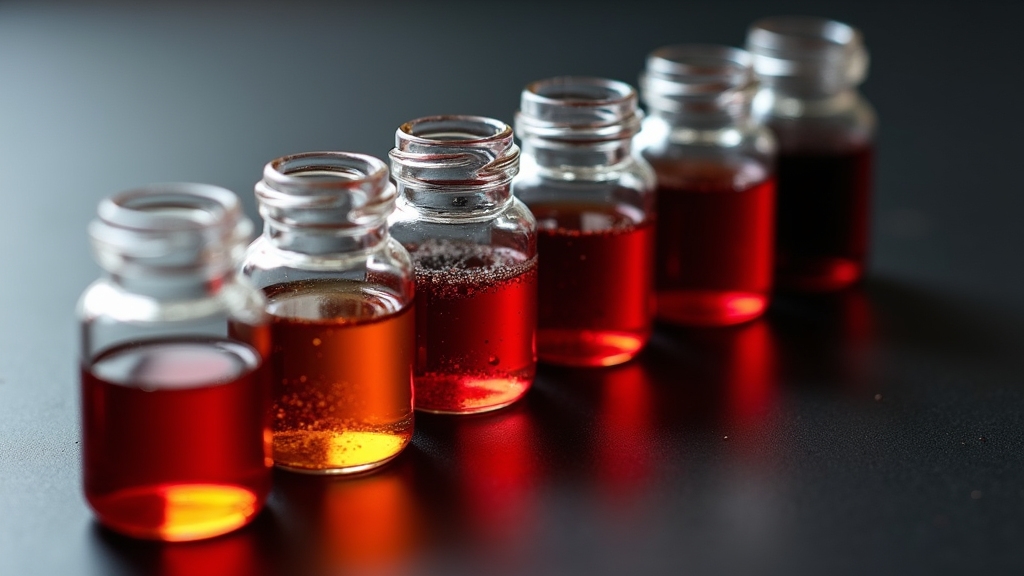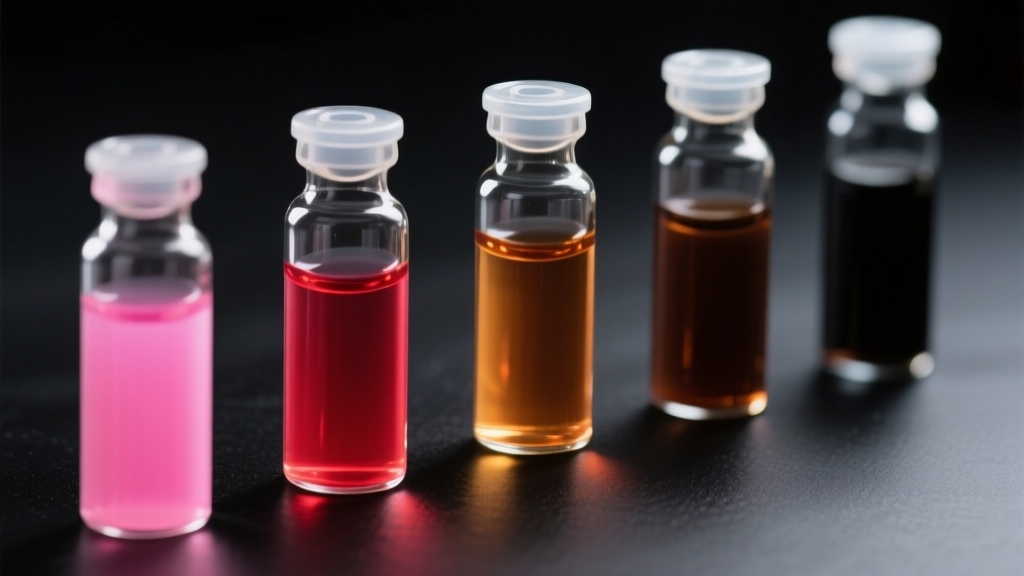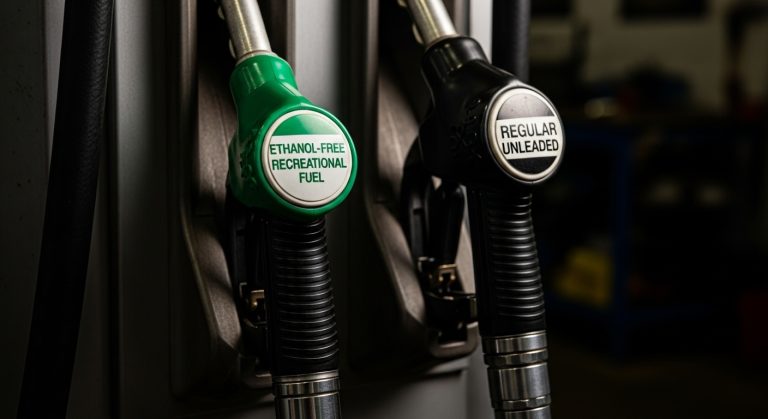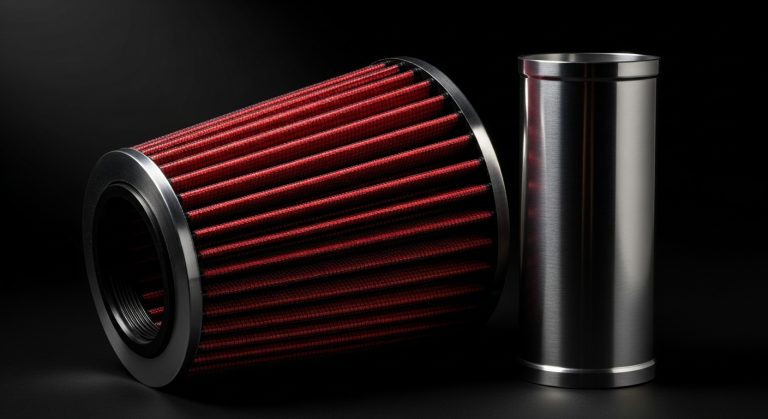You should regularly check your transmission fluid color to gauge its health and spot issues early. Bright red fluid indicates fresh, effective lubrication, while dark red suggests aging but usable fluid.
Warning signs include dark brown or black fluids with burnt smells, signaling oxidation or contamination that needs attention. Driving conditions, like towing, can accelerate color changes.
Proper checking involves warm engine and level vehicle, following manufacturer guidelines. Understanding these basics helps protect your transmission’s longevity and performance.
Key Takeaways
- Bright red or pink transmission fluid indicates new or healthy fluid with optimal lubrication and no immediate service required.
- Dark red or light brown fluid signals aging but may still function; monitor for burning smell or slipping gears.
- Dark brown or black fluid shows severe oxidation or contamination, often with burnt smell and gritty texture, requiring fluid change.
- Pink or milky fluid suggests water or coolant contamination, needing urgent inspection to prevent transmission damage.
- Regularly check fluid color when warm and vehicle level, following manufacturer guidelines to maintain transmission health and prevent costly repairs.
Quick Reference Transmission Fluid Color Chart
| Fluid Color | Condition Status | Lubrication Quality | Action Required | Estimated Service |
|---|---|---|---|---|
| Bright Red | Excellent – Like new | Optimal protection | None needed | Continue monitoring |
| Dark Red | Good – Normal aging | Adequate function | Monitor closely | Consider service soon |
| Light Brown | Fair – Early oxidation | Declining efficiency | Schedule change | Within 5,000 miles |
| Dark Brown | Poor – Significant wear | Compromised protection | Change immediately | Overdue service |
| Black | Critical – Severe damage | Failed lubrication | Emergency service | Risk of transmission failure |
| Pink/Milky | Contaminated – Water/coolant | Dangerous mixture | Stop driving | Immediate inspection |
About Transmission Fluid Colors

Although often overlooked, transmission fluid color plays a crucial role in diagnosing transmission health, providing you with immediate visual cues about the fluid’s condition and potential issues within the system. Regular monitoring of fluid condition is as important as adhering to maintenance recommendations for vehicle health.
Fresh transmission fluid exhibits a bright red or pink hue, indicating effective lubrication and the presence of essential additives.
Bright red or pink transmission fluid signals optimal lubrication and vital additives at work.
As the fluid ages, normal oxidation and minor contamination cause it to darken to deeper red shades. You’ll notice light brown, semi-transparent fluid when it’s aged but still functional.
However, brown or dark brown opaque fluid signals contamination, oxidation, and compromised lubrication.
Black or very dark fluid denotes severe deterioration and high heat exposure, risking imminent transmission failure.
Regular checks prevent serious maintenance issues by identifying early signs of fluid degradation.
Monitoring these color variations enables you to detect fluid breakdown early, guiding maintenance schedules and preventing costly repairs.
Common Transmission Fluid Color Variations
When you examine transmission fluid, its color immediately reveals key information about the fluid’s condition and the transmission’s health. Bright red fluid typically indicates new or well-maintained fluid, signaling proper lubrication and a healthy transmission.
Transmission fluid also acts as a hydraulic fluid, aiding torque converter, valve body, and clutch friction for smooth gear shifting and power delivery hydraulic function. Choosing components with high filtration efficiency can help maintain fluid quality longer.
As fluid ages, it may turn dark red or light brown, showing normal wear and minor contamination but generally remaining functional. However, dark brown to black fluid signals severe oxidation, contamination, and degraded performance, necessitating immediate replacement to prevent damage.
Pink transmission fluid usually indicates contamination by water or coolant, causing lubrication failure and requiring urgent mechanical inspection.
Less common variations include yellow or blue fluids, and extremely clear fluid may signal a recent change or low levels.
Always confirm fluid type to avoid mixing and ensure system integrity.
Causes of Transmission Fluid Color Changes

Because transmission fluid constantly operates under high temperatures and mechanical stress, its color changes primarily result from oxidation, contamination, and chemical breakdown. Oxidation darkens the fluid as heat and air degrade its quality, turning bright red fluid to brown or black.
Mechanical wear introduces metal and clutch particles, further darkening and contaminating the fluid. Chemical breakdown alters dye composition and additive effectiveness, causing color shifts and sludge formation.
Regular fluid checks and changes help maintain transmission health by preventing the fluid from becoming overly degraded. Understanding the balance between performance goals and engine protection is crucial for optimal maintenance.
| Cause | Effect on Fluid Color |
|---|---|
| Oxidation and Heat | Bright red to brown to black |
| Mechanical Wear | Darkening due to metal debris |
| Chemical Breakdown | Dye fading and sludge formation |
Monitoring these changes helps you detect fluid degradation and potential transmission damage early.
Interpreting Bright Red Transmission Fluid
If you spot bright red transmission fluid on your dipstick or during an inspection, you can be confident that the fluid is in ideal condition. This vibrant, translucent red indicates the fluid is new or like-new, containing manufacturer-added dyes for easy identification.
Bright red fluid ensures excellent lubrication, smooth gear shifting, and effective transmission operation without grinding or slipping. Its slightly oily, sweet or petroleum scent distinguishes it from other red fluids like power steering fluid or coolant. The fluid’s composition plays a crucial role in preventing corrosion protection inside transmission components.
The fluid’s consistency should be balanced—not too thick or thin—signaling proper viscosity. Bright red color stability depends on minimal heat exposure and absence of contaminants.
Routine checks help maintain this condition, ultimately extending transmission lifespan and delaying costly repairs. Leaks typically appear toward the middle or back of the vehicle, which can help confirm the source as transmission fluid leak location.
No immediate service or fluid change is needed when fluid appears bright red.
What Dark Red Transmission Fluid Indicates?

Although dark red transmission fluid signals natural aging, it generally maintains adequate lubricating and hydraulic properties for normal operation. This color shift from bright red results from oxidation and accumulation of debris particles but doesn’t necessarily indicate fluid failure.
It is important to note that dirty or degraded fluid can increase wear on internal components if left unchecked. Similar to how fluid longevity varies in automotive components, monitoring transmission fluid color helps ensure optimal system performance.
You should regularly monitor the fluid using the dipstick to track any progression beyond dark red toward brown or black, which denotes severe degradation and potential transmission issues.
Dark red fluid still supports normal performance; however, watch for accompanying symptoms like burning smells, slipping gears, or delayed shifting, which suggest overheating or contamination.
Prompt fluid service becomes essential if these signs appear or if the fluid darkens further. Maintaining vigilance ensures you address transmission health proactively, preventing costly damage linked to advanced fluid breakdown.
Identifying Light Brown and Orange Fluid Conditions
When you notice your transmission fluid turning light brown or orange, it often signals oxidation and aging of the fluid, which reduces its protective qualities. Fluid in this state is still see-through and can continue to aid transmission and gear shifting, indicating moderate aging.
Orange fluid can also result from certain additives or dyes, but persistent discoloration usually indicates thermal breakdown or contamination.
Recognizing these color changes early helps you schedule timely fluid service to prevent internal transmission damage. Proper maintenance and replacement intervals are crucial to maintain optimal transmission performance.
Causes of Light Brown
Because light brown transmission fluid results primarily from oxidation, you’ll notice its color shift as air bubbles trapped during operation react chemically with the fluid. This oxidation process gradually alters the fluid’s composition, turning it from bright red to light brown.
Heat exposure accelerates this chemical breakdown, while minor contamination with debris, metal particles, and dirt further darkens the fluid over time. Extended use beyond recommended service intervals, typically around 50,000 miles, worsens oxidation and contamination.
Light brown fluid usually signals early-stage degradation without severe overheating or mechanical failure. Although the fluid retains some lubrication, its efficiency declines, increasing wear risk. Regularly inspecting fluid levels and appearance is important for early detection of such issues.
Monitoring fluid color and scheduling timely flushes help prevent progression to harmful conditions, maintaining transmission health and performance. Driving under harsh conditions can accelerate fluid breakdown due to increased thermal stress and mechanical wear.
Orange Fluid Indicators
A distinctive orange hue in your transmission fluid often signals oxidation and aging, which degrades its protective properties. This color shift typically occurs as the original bright red fluid darkens due to prolonged exposure to heat and oxygen.
While orange fluid may resemble light brown, it’s brighter and more translucent, helping you distinguish between aging fluid and other contaminants like motor oil or gear lubricant. Understanding the balance between durability and cost can also guide maintenance decisions.
Orange fluid can also result from rust or coolant contamination if a radiator leak is present. Often, this discoloration is linked to rusty Radiator leaks, which may cause condensation under the vehicle.
You should watch for symptoms such as burning odors, slipping, or erratic shifting, which indicate fluid breakdown. Regularly check the dipstick for color changes and schedule a fluid change or flush promptly to prevent overheating and transmission wear.
Signs of Contaminated or Burnt Transmission Fluid
If your transmission fluid appears dark brown or black, it’s a clear sign the fluid has burnt and degraded due to excessive heat and wear. This often results in reduced lubricity benefits within the transmission system.
You’ll likely notice a distinct burnt smell, indicating the fluid’s protective properties have broken down.
Additionally, a sticky or gritty texture confirms contamination, signaling the need for immediate fluid inspection and replacement.
Regular checks of the transmission fluid’s color and smell can help detect these issues early before severe damage occurs.
Dark Brown or Black
How can you tell when your transmission fluid has become contaminated or burnt? When the fluid darkens to dark brown or black, it signals significant contamination.
This discoloration results from internal wear releasing metal particles, overheating that accelerates fluid breakdown, oxidation from heat and air exposure, and clutch material deterioration adding carbon debris.
Both AMSOIL and Mobil 1 synthetic oils demonstrate superior protection against oxidation compared to conventional oils, which can be crucial in preventing such fluid breakdown.
Dark brown fluid indicates reduced lubrication and cooling effectiveness, while black fluid suggests severe contamination and possible internal damage. If you notice thickened fluid or visible particles, it means contaminants have compromised fluid flow and component function.
Transmission fluid also plays a crucial role in creating hydraulic pressure necessary for smooth gear shifts, so contamination can directly impair transmission performance.
Such fluid conditions lead to increased friction, gear slipping, and harsh shifting. Regular fluid inspections and timely replacements every 30,000 to 60,000 miles help prevent this degradation and maintain transmission health. Using high-quality synthetic products with enhanced viscosity resistance can extend fluid life and improve transmission reliability.
Burnt Smell and Texture
When transmission fluid develops a burnt smell and changes texture, it signals severe contamination and thermal degradation. You’re likely dealing with fluid that’s overheated due to worn parts, faulty torque converters, or harsh operating conditions.
Burnt fluid often smells acrid, sometimes like burning plastic or smoke, and its texture shifts from slick to thick, sludgy, or gritty. In hot weather, transmission fluid can overheat more easily if it is not properly maintained, accelerating the breakdown process. Pay attention to these signs:
- Darkened color from bright red to brown or black indicates thermal breakdown
- Sludge buildup and gritty particles from clutch material contamination
- Impaired lubrication causing rough shifting, slipping gears, or transmission noise
Ignoring these symptoms risks permanent damage. Detecting burnt fluid early and replacing it promptly preserves your transmission’s hydraulic function and prevents costly repairs.
How Driving Conditions Affect Fluid Color?
Because driving conditions directly influence transmission fluid temperature and stress levels, they substantially affect the fluid’s color and condition.
Frequent stop-and-go traffic, towing heavy loads, and driving in mountainous terrain increase operating temperatures, accelerating fluid oxidation and darkening its color from bright red to brown or black. Transmission fluid is designed to lubricate and protect internal transmission components as it circulates.
Driving conditions raise transmission fluid temperature, speeding oxidation and darkening fluid from bright red to brown or black.
Aggressive driving habits cause overheating, breaking down lubricating properties and thickening the fluid. Prolonged heat exposure can burn clutch material, contaminating fluid with dark particles and metal shavings, signaling internal wear.
Additionally, contamination from dirt or coolant dilution alters fluid color, with pink hues indicating serious leaks. Monitoring fluid color under varied driving stresses helps you detect early degradation, allowing timely maintenance to prevent costly transmission damage.
Severe conditions require more frequent fluid changes than standard intervals to maintain ideal performance.
Steps to Check Transmission Fluid Color Properly
Start by locating the transmission fluid dipstick under the hood, distinct from the engine oil dipstick. Make certain the engine is warm and the vehicle is on level ground before carefully removing and wiping the dipstick clean.
It is important to check the fluid when the engine is warm and running for an accurate reading. Then, reinsert it fully, withdraw it again, and immediately inspect the fluid’s color and clarity for an accurate assessment.
Locating the Dipstick
Although locating the transmission dipstick varies by vehicle, you can typically find it near the engine connected to the transmission.
Rear-wheel-drive cars usually have the dipstick toward the back of the engine, while front-wheel-drive models position it near the transaxle at the front, often close to the oil dipstick. The dipstick handle is generally brightly colored, yellow or orange, for easy identification.
To locate your transmission dipstick:
- Consult the owner’s manual to confirm presence and exact location, as some newer or manual vehicles lack a dipstick.
- Look for a labeled tube or brightly colored handle under the hood.
- If unsure, seek guidance from dealership resources or professional technicians.
- Always check the owner’s manual to determine if the transmission fluid should be checked when warm or cold.
Following these steps ensures you accurately identify the dipstick before checking fluid levels.
Inspecting Fluid Appearance
After locating and removing the transmission dipstick, the next step involves carefully inspecting the fluid’s appearance to assess its condition.
Wipe the dipstick clean, reinsert it, then withdraw it to observe the fluid’s color, consistency, and odor under good lighting. Regular checks help maintain transmission health and performance by identifying early signs of wear or contamination.
Compare your observations against expected fluid types and colors to diagnose issues early.
| Fluid Color | Meaning | Action Required |
|---|---|---|
| Bright Red | Healthy, new fluid | No immediate action |
| Dark Brown | Oxidized, degraded | Schedule fluid change |
| Pink/Milky | Contaminated with water | Urgent inspection needed |
Check fluid level alongside color to ensure proper transmission function, as transmission fluid transmits power from the engine to the wheels enabling smooth vehicle motion.
Manufacturer Guidelines and Fluid Color Differences
When choosing the correct transmission fluid, you must follow manufacturer guidelines closely, as each automaker specifies fluid types tailored to their transmissions’ design and performance requirements.
For example, General Motors recommends Dexron VI for ATF, Ford requires Mercon V, and Chrysler uses ATF+4. Colors vary by type and brand to reflect formulation differences and compatibility. It is important to use factory-specified fluids to ensure optimal transmission performance and avoid damage.
Keep these points in mind:
Key factors like fluid chemistry and color are crucial for proper transmission performance and compatibility.
- Automatic fluids are generally red or pink; manuals use brown or amber.
- Specialty fluids, like Mercedes-Benz’s Pentosin ATF 134 variants, have unique colors (red, blue) to indicate specific properties and compatibility.
- Color-coding shows fluid chemistry differences essential for friction stability, thermal resistance, and wear protection.
Always consult your vehicle’s manual to match fluid type and color precisely.
Frequently Asked Questions
Can Transmission Fluid Color Affect Fuel Efficiency?
Transmission fluid color itself doesn’t directly affect fuel efficiency, but it signals the fluid’s condition, which impacts performance.
When fluid darkens, it means degradation and contamination have occurred, reducing lubrication and increasing friction inside the transmission.
This extra resistance forces your engine to work harder, lowering fuel economy.
Does Synthetic Fluid Change Color Differently Than Conventional Fluid?
Yes, synthetic fluid changes color differently than conventional fluid. You’ll notice synthetic fluid stays brighter red longer because it resists oxidation and thermal breakdown better.
Conventional fluid darkens faster due to quicker contamination and molecular degradation. While both darken with age, synthetic additives slow this process, helping you extend change intervals.
Still, you should monitor fluid color regularly since darkening signals wear or contamination regardless of fluid type.
How Does Transmission Fluid Color Affect Warranty Coverage?
About 70% of warranty claims involving transmissions hinge on fluid condition. Your transmission fluid color directly affects warranty coverage because manufacturers view clear red fluid as proof of proper maintenance.
Dark or milky fluid often signals neglect or contamination, risking claim denial. To keep coverage valid, you must follow OEM fluid change intervals and maintain records.
Fluid color analysis also helps verify if damage stems from covered defects or user error.
Is Color Alone Enough to Diagnose Transmission Problems?
No, color alone isn’t enough to diagnose transmission problems. You need to take into account fluid smell, texture, level, and vehicle symptoms like slipping or noise.
Color changes can indicate fluid degradation but don’t reveal specific mechanical issues. Relying solely on color risks misdiagnosis and unnecessary repairs.
Always combine color observations with professional inspections and fluid analysis for accurate transmission health assessment and timely maintenance decisions.
Can Additives Restore Burnt Transmission Fluid Color?
No, additives can’t restore burnt transmission fluid color. They focus on cleaning deposits, reducing friction, and improving shifting, but don’t reverse the chemical breakdown causing discoloration.
While additives might slightly improve clarity by suspending particles, they won’t bring back the original bright red or amber hues.
To properly address burnt fluid, you need a full fluid flush and replacement.
Rely on additives for maintenance, not color restoration.
Take Charge of Your Transmission Health Today
You should know that nearly 30% of transmission failures stem from neglected fluid issues, highlighting the importance of monitoring fluid color regularly. By understanding the differences from bright red indicating healthy fluid to dark or burnt hues signaling problems, you can prevent costly repairs.
Always follow manufacturer guidelines when checking your transmission fluid to guarantee accuracy. Staying vigilant about fluid color helps maintain ideal transmission performance and extends your vehicle’s lifespan effectively.




